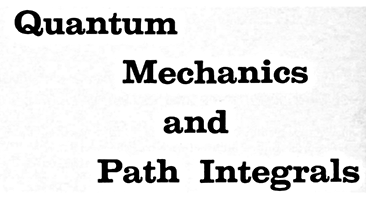
\(\)
Problem 6-4
Using arguments similar to those leading to Eq. (6-19), show that the wave function \(\psi(b)\) satisfies the integral equation
\begin{equation}
\psi(b)=\phi(b)-\frac{i}{\hbar}\int d\theta_c\,K_0(b,c)\,V(c)\,\psi(c)
\tag{6-26}
\end{equation}
\psi(b)=\phi(b)-\frac{i}{\hbar}\int d\theta_c\,K_0(b,c)\,V(c)\,\psi(c)
\tag{6-26}
\end{equation}
This integral equation is equivalent to the Schrödinger equation
\begin{equation}
\def\ppdiff#1#2{\frac{\partial #1}{\partial #2}}
-\frac{\hbar}{i}\ppdiff{\psi}{t}+\frac{\hbar^{2}}{2m}\nabla^{2}\psi -V\psi =0
\tag{6-27}
\end{equation}
\def\ppdiff#1#2{\frac{\partial #1}{\partial #2}}
-\frac{\hbar}{i}\ppdiff{\psi}{t}+\frac{\hbar^{2}}{2m}\nabla^{2}\psi -V\psi =0
\tag{6-27}
\end{equation}
Working in one dimension only, show how the Schrödinger equation may be deduced from the integral equation.
( 解答 ) 原書及び訳本では, 式 (6-27) の左辺の最終項が \(+V\psi\) となっているが, これも明らかにプリントミスと思われるので修正しておく (校訂版では修正されていた).
過去の時刻 \(t_a\) での波動関数を \(\psi(a)\) と書くならば, 時刻 \(t_b\) に於ける波動関数 \(\psi(b)\) は式 (6-22) から次に書ける:
\begin{equation}
\psi(b)=\int dx_a\,K_V(b,a)\,\psi(a)
\tag{1}
\end{equation}
\psi(b)=\int dx_a\,K_V(b,a)\,\psi(a)
\tag{1}
\end{equation}
この式中の核 \(K\_V(b,a)\) として, 前節の結果式 (6-17) を代入するならば,
\begin{align}
&\psi(b)=\int dx_a\,\left[K_0(b,a)-\frac{i}{\hbar}\int_{t_a}^{t_b}dt_c\int_{-\infty}^{\infty}dx_c
\,K_0(b,c)\,V(c)\,K_0(c,a)\right.\\
&\qquad\quad\left.+\left(-\frac{i}{\hbar}\right)^{2}\int d\theta_c\int d\theta_d\,K_0(b,c)\,V(c)\,K_0(c,d)\,
V(d)\,K_0(d,a)+\dotsb\right]\,\psi(a)\\
&=\int dx_a\,K_0(b,a)\psi(a)-\frac{i}{\hbar}\int_{t_a}^{t_b}dt_c\int_{-\infty}^{\infty}dx_c
\,K_0(b,c)\,V(c)\int dx_a\,K_0(c,a)\,\psi(a)+\dotsb
\end{align}
&\psi(b)=\int dx_a\,\left[K_0(b,a)-\frac{i}{\hbar}\int_{t_a}^{t_b}dt_c\int_{-\infty}^{\infty}dx_c
\,K_0(b,c)\,V(c)\,K_0(c,a)\right.\\
&\qquad\quad\left.+\left(-\frac{i}{\hbar}\right)^{2}\int d\theta_c\int d\theta_d\,K_0(b,c)\,V(c)\,K_0(c,d)\,
V(d)\,K_0(d,a)+\dotsb\right]\,\psi(a)\\
&=\int dx_a\,K_0(b,a)\psi(a)-\frac{i}{\hbar}\int_{t_a}^{t_b}dt_c\int_{-\infty}^{\infty}dx_c
\,K_0(b,c)\,V(c)\int dx_a\,K_0(c,a)\,\psi(a)+\dotsb
\end{align}
よって, 時刻 \(t_b\) に於ける無摂動の波動関数を式 (6-24) と同様に
\begin{equation}
\phi(b)=\int dx_a\,K_0(b,a)\psi(a),\quad \phi(c)=\int dx_a\,K_0(c,a)\psi(a),\quad\dotsb
\tag{2}
\end{equation}
\phi(b)=\int dx_a\,K_0(b,a)\psi(a),\quad \phi(c)=\int dx_a\,K_0(c,a)\psi(a),\quad\dotsb
\tag{2}
\end{equation}
と記すならば, 上式は式 (6-26) のように書ける:
\begin{align}
\psi(b)&=\phi(b)-\frac{i}{\hbar}\int_{t_a}^{t_b}dt_c\int_{-\infty}^{\infty}dx_c\,K_0(b,c)\,V(c)
\left[\phi(c)-\frac{i}{\hbar}\int d\theta_d\,K_0(c,d)V(d)\phi(d)+\dotsb\right]\\
&=\phi(b)-\frac{i}{\hbar}\int_{t_a}^{t_b}dt_c\int_{-\infty}^{\infty}dx_c\,K_0(b,c)\,V(c)\,\psi(c)\\
&=\phi(b)-\frac{i}{\hbar}\int d\theta_c\,K_0(b,c)\,V(c)\,\psi(c)
\tag{3}
\end{align}
\psi(b)&=\phi(b)-\frac{i}{\hbar}\int_{t_a}^{t_b}dt_c\int_{-\infty}^{\infty}dx_c\,K_0(b,c)\,V(c)
\left[\phi(c)-\frac{i}{\hbar}\int d\theta_d\,K_0(c,d)V(d)\phi(d)+\dotsb\right]\\
&=\phi(b)-\frac{i}{\hbar}\int_{t_a}^{t_b}dt_c\int_{-\infty}^{\infty}dx_c\,K_0(b,c)\,V(c)\,\psi(c)\\
&=\phi(b)-\frac{i}{\hbar}\int d\theta_c\,K_0(b,c)\,V(c)\,\psi(c)
\tag{3}
\end{align}
次に, 演算子 \((-\hbar/i)\partial/\partial t_b+(\hbar^{2}/2m)\partial^{2}/\partial x_b^{2}-V(b)\) を式 (1) に作用させてみる.右辺では, これらは全て核 \(K_V(b,a)\) に作用することに注意すると,
\begin{align}
\def\pdiff#1{\frac{\partial}{\partial #1}}
\def\Bppdiff#1#2{\frac{\partial^{2}#1}{\partial #2^{2}}}
\def\Bpdiff#1{\frac{\partial^{2}}{\partial #1^{2}}}
&\left[-\frac{\hbar}{i}\pdiff{t_b}+\frac{\hbar^{2}}{2m}\Bpdiff{x_b}-V(b)\right]\, \psi(b)
=-\frac{\hbar}{i}\ppdiff{\psi(b)}{t_b}+\frac{\hbar^{2}}{2m}\Bppdiff{\,\psi(b)}{x_b}-V(b)\,\psi(b)\\
&=\int dx_a\,\left[-\frac{\hbar}{i}\pdiff{t_b}K_V(b,a)+\frac{\hbar^{2}}{2m}\Bpdiff{x_b}K_V(b,a)-V(b)\,K_V(b,a)\right]\,\psi(a)
\tag{4}
\end{align}
\def\pdiff#1{\frac{\partial}{\partial #1}}
\def\Bppdiff#1#2{\frac{\partial^{2}#1}{\partial #2^{2}}}
\def\Bpdiff#1{\frac{\partial^{2}}{\partial #1^{2}}}
&\left[-\frac{\hbar}{i}\pdiff{t_b}+\frac{\hbar^{2}}{2m}\Bpdiff{x_b}-V(b)\right]\, \psi(b)
=-\frac{\hbar}{i}\ppdiff{\psi(b)}{t_b}+\frac{\hbar^{2}}{2m}\Bppdiff{\,\psi(b)}{x_b}-V(b)\,\psi(b)\\
&=\int dx_a\,\left[-\frac{\hbar}{i}\pdiff{t_b}K_V(b,a)+\frac{\hbar^{2}}{2m}\Bpdiff{x_b}K_V(b,a)-V(b)\,K_V(b,a)\right]\,\psi(a)
\tag{4}
\end{align}
右辺の被積分項に対して問題 6-3 の式 (6-21) を利用することで次となる:
\begin{align}
-\frac{\hbar}{i}\pdiff{t_b}\psi(b)+\frac{\hbar^{2}}{2m}\Bpdiff{x_b}\psi(b)-V(b)\,\psi(b)
&=i\hbar\delta(t_b-t_a)\int dx_a\,\,\delta(x_b-x_a)\,\psi(a)\\
&=i\hbar\delta(t_b-t_a)\,\psi(b)
\tag{5}
\end{align}
-\frac{\hbar}{i}\pdiff{t_b}\psi(b)+\frac{\hbar^{2}}{2m}\Bpdiff{x_b}\psi(b)-V(b)\,\psi(b)
&=i\hbar\delta(t_b-t_a)\int dx_a\,\,\delta(x_b-x_a)\,\psi(a)\\
&=i\hbar\delta(t_b-t_a)\,\psi(b)
\tag{5}
\end{align}
しかしながら, 今考えているのは時刻 \(t_b\) に於ける微分方程式であるので, 明らかに右辺の時間についてのデルタ関数はゼロである.従って, この式 (5) の右辺はゼロとなる.よって, 1次元の場合の式 (6-27) に相当する式として次式が得られる:
\begin{equation}
-\frac{\hbar}{i}\ppdiff{\psi(b)}{t_b}+\frac{\hbar^{2}}{2m}\Bppdiff{\,\psi(b)}{x_b}-V(b)\,\psi(b)=0
\tag{6}
\end{equation}
-\frac{\hbar}{i}\ppdiff{\psi(b)}{t_b}+\frac{\hbar^{2}}{2m}\Bppdiff{\,\psi(b)}{x_b}-V(b)\,\psi(b)=0
\tag{6}
\end{equation}
